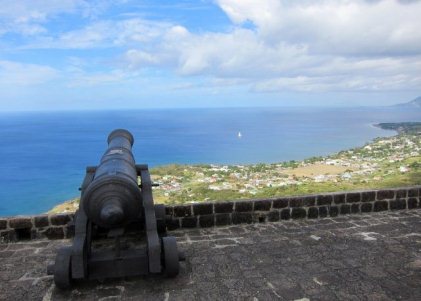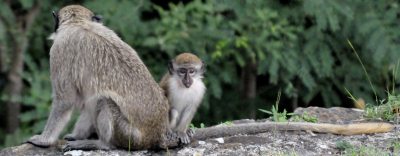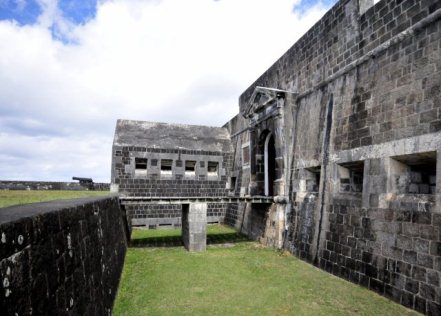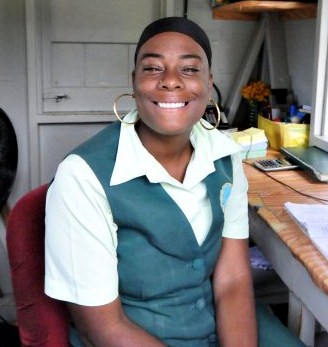Brimstone Hill Fortress

|
Brimstone Hill Fortress National Park
   Everton picked us up promptly at eight thirty to take us to the fort. Supposed to be one of the most impressive, with amazing views. We got there at nine, place opened at nine thirty, never been that early as a tourist before. Gave us a chance to chat to a security man about cricket, monkeys, islands we could see and general chit-chat. I wondered why Bear was not leaping at his usual 'button pressing' on this cannon. Well his new thing is being bitten by red ants. I think he is trying to take my crown - I was the one bitten by a falling soldier ant on my left bazooka, so the odd one on the feet is no challenge - YET. So far it was a nest in Grenada, a nest in Montserrat now here on his cannon. He is a bit ginger with his little friends now and acts cautiously around them. So no "button press" here, but a great view, Bear's nest, quite neat really the tunnel they built.  
Finally staff arrive, Caribbean style. My new friend, the security man came and got me as a "flocking" of Vervet Monkeys appeared (least that's what I thought he said)
. Cannon were first mounted on Brimstone Hill in 1690, when the British used them to recapture Fort Charles from the French. The French had not considered it possible to transport cannon up the steep and thickly wooded sides of Brimstone Hill. The British realised the potential of the hill as a place of defence and proceeded to fortify it. The Fortress was designed by British military engineers and built and maintained by African slaves. The construction of the fort then carried on intermittently for just over one hundred years. In its heyday, the fort was known as 'The Gibraltar of the West Indies', in reference to its imposing height and seeming invulnerability. In 1782, the French, under Admiral Comte Francois Joseph Paul de Grasse laid siege to the fort. During the siege, the adjacent island of Nevis surrendered, and guns from Fort Charles and other small forts there were brought to St. Kitts for use against Brimstone Hill. British Admiral Hood could not dislodge de Grasse and his eight thousand soldiers. The one thousand defenders made up of Royal Scots and East Yorkshire Regiments, local militia and escaped slaves fought valiantly and after a month of siege, these heavily outnumbered and cut-off British garrison finally surrendered on the 12th of February. The French allowed the defenders to march out with all the honours of war. However, a year later, the Treaty of Paris (1783) restored St. Kitts and Brimstone Hill to British rule, along with the adjacent island of Nevis. Following these events, the British carried out a program to augment and strengthen the fortifications, and Brimstone Hill never again fell to an enemy force. It is one of the best preserved historical fortifications in the Americas. The fort was abandoned by the British in 1852 after the troops were reassigned. The structures gradually decayed through vandalism and weathering.

Bear had picked up his audio tour gadget- now used in the Who Goes There position from Cindy at the gate (Oh she reminded me of Julie- more later). Just inside the gate is the Barrier Reden where four cannon were mounted to protect the road. Through the first archway and past Magazine Bastion (the massive walls were breached by the French in 1782) a grassed road leads to the Orillon Bastion.
 
The Society for the Restoration of Brimstone Hill was founded in 1965. In 1973 HRH Prince Charles reopened the first area to be completely restored, the Prince of Wales Bastion. Fort George Museum was set up and in 1985 Queen Elizabeth II unveiled a plaque naming Brimstone Hill as a National Park. Legislation in 1987 officially declared National Park status, the D. Lloyd Matheson Visitors' Centre named in honour of a former president of the Society was opened in 1992 and the fort was declared a World Heritage Site in 1999.
 
Further along the paved road, the ruins of the Royal Engineers' Quarters can be seen. The road continues past the site of the Adjutant's Quarters then along the solid walls of the Prince of Wales Bastion, through the second archway and up to the Parade Ground, now the main parking area. Then we went into the Visitors' Centre to watch a dvd about the fort and look at the interesting information displays. The restored Commissariat building also houses a small gift shop. Opposite is the Warrant Ofiicers' Quarters also restored.

Below the grassy slopes of Monkey Hill is the ruin of the Artillery Officers' Quarters (back of picture), which was once the finest residence of the Fortress, with spectacular views of the south coast of St Kiits, Nevis and even Montserrat on a clear day. There is a restored kitchen and stairs lead down to the Officers' Privy.The Infantry Officers' Quarters was originally a two storey building, but the upper storey was destroyed by a hurricane. The Canteen and toilets are a reconstruction of the stone building which replaced the original top storey. Steps down from the Infantry Officers' Quarter lead to the green tank once the largest cistern of the Fortress, holding 100,000 gallons of water collected in the semi-circular catchment. The steps continue down to the Orillon Bastion where the hospital was located.
No comment required - but I got to press as well
 
Magazine Bastion. The Main Ordnance Store is a building of tremendous strength with some walls six feet thick. At the cemetery in the Orillon a number of tomb stones can still be seen
The Prince of Wales Bastion was the first building to be completely restored and housed the Brigade office, the main guard barracks and a powder magazine. Now it contains the conference / banquet facility which can be hired for public functions and is a popular wedding venue. The Citadel is the showplace of the Fortress. At the top or the ramp is the Western Place of Arms with three sentinel 24-pounder cannon overlooking the Caribbean Sea with breathtaking views all around. As you cross the bridge over the dry moat you enter the Fort George Museum. Where a variety of artifacts reflect the history of the Fortress and of the island are displayed in restored barrack rooms.
  
The Citadel is an outstanding architectural and engineering monument. Passing through the Citadel you reach the Eastern Place of Arms where cannon point to the mountains
 
After our tour and I forced Bear to give back 'his lady'. I stopped to chat to Cindy on the gate. I was spooked to begin with but after ten minutes chatting, told her that if she were white, she would be Julie at that age -same laugh, same voice. I tried to get her to smile showing her bottom teeth, but all she could do was giggle (Carolyn can you see it?). Still reeling off we went again with Everton.
ALL IN ALL AN AWESOME PLACE TO VISIT
MAGNIFICENT PIECE OF
ENGINEERING |

















